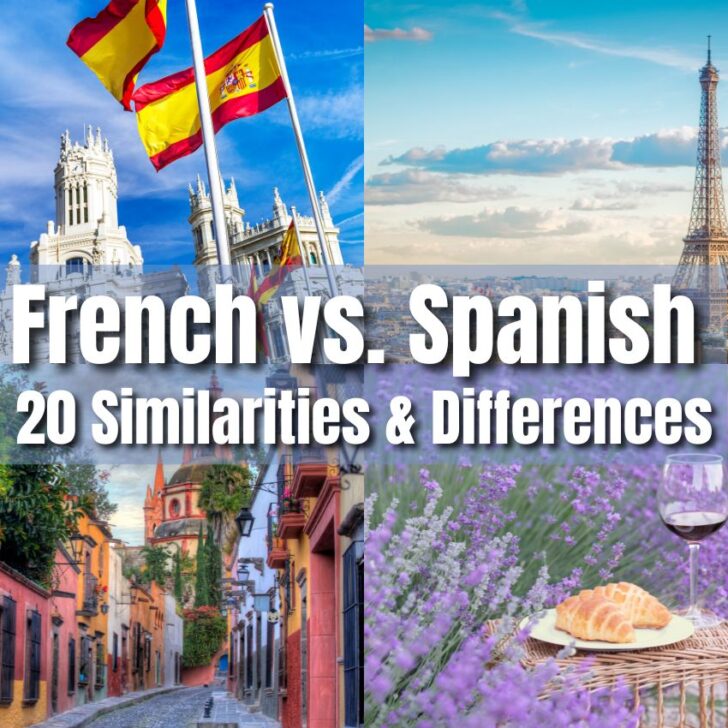French vs Spanish: “Should I learn French or Spanish?” This article will help you decide which language is more useful as well as look at similarities and differences. If your main objective is to live, work or travel in the French-speaking world (France, Canada and elsewhere), it would be better to learn French. If you want to live, work and travel in Spain or most of South America, it would better to learn Spanish.
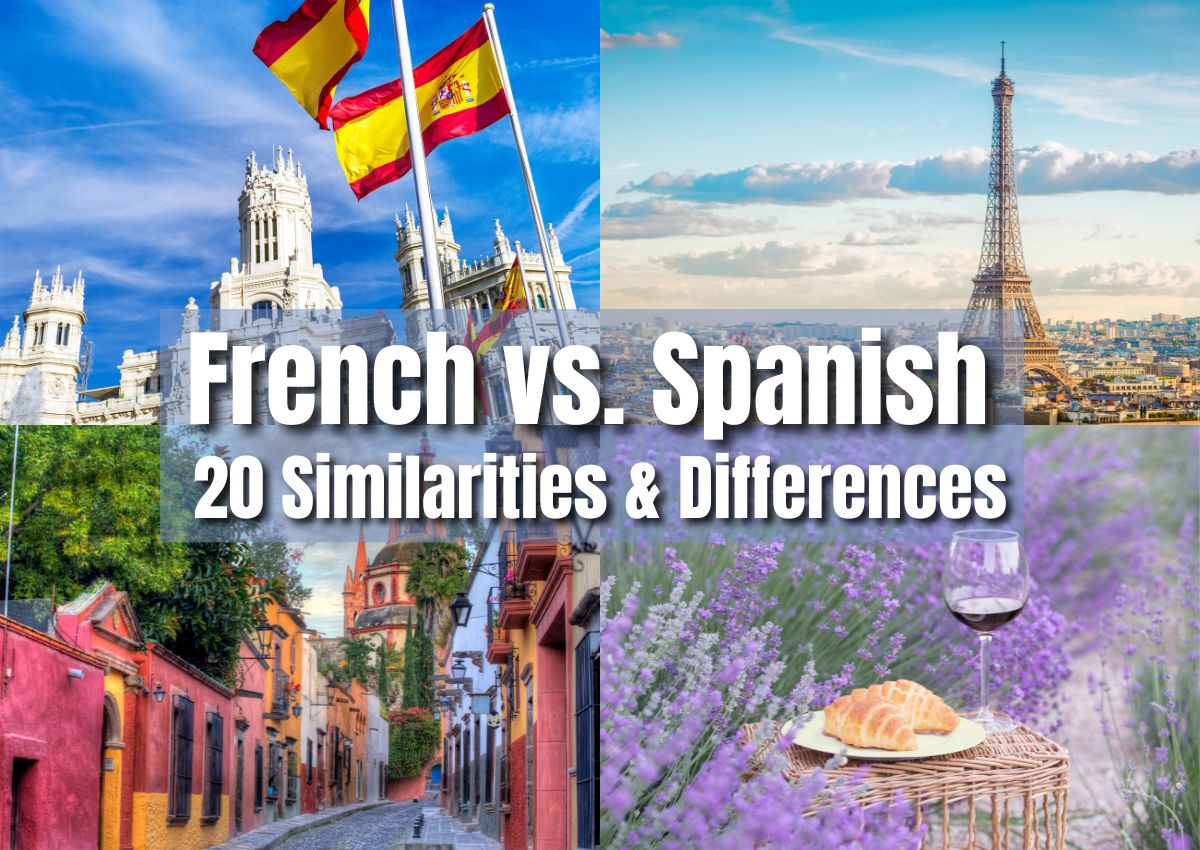
French vs. Spanish: What language should I learn?
Why learn French?
They key reason for learning French is that it will give you access to all of the French speaking world. According to the French wiki page, there are approximately 80 million native speakers worldwide.
The biggest French speaking areas of the world are: Western Europe (France, Belgium, Switzerland and Luxembourg), Western Africa (Democratic Republic of the Congo, Cameroon, Ivory Coast and more) and Canada (mostly Quebec province).
According to Worldatlas.com, the world’s four biggest French-speaking cities are Kinshasa, Democratic Republic Of Congo, Paris France, Abidjan, Ivory Coast, and Montreal, Canada.
In Canada there are just under 35 million French speakers, according to Canada.ca.
Thus, if you’re planning on living in Canada, learning French is a very good idea. Knowledge of French and bilingualism is often a requirement for finding employment, especially in Quebec.
In the United States, however, learning French is not as useful. In the USA, knowledge of French is very rarely a requirement in the job market.
All off that said, what’s the biggest reason to learn French? It sounds so pretty! French is one on the most beautiful languages in the world. Furthermore, knowing French is a huge advantage for discovering France’s cultural richness and fascinating history.

Why learn Spanish?
According to Wikipedia, Spanish is the second most spoken language in the world after Mandarin Chinese and before English. According to Wikipedia, the there are approximately 480 million Spanish speakers world wide.
This means that there are about six times more Spanish speakers on this planet than French speakers. Thus, Spanish is a major world language.
The three main geographical areas made accessible by learning Spanish are Spain in Europe, almost all of Latin America (Portuguese is spoken in Brazil), and several major Caribbean island nations such as Cuba and the Dominican Republic.
Learning Spanish will give you access to all of Mexico, the United States’ major neighbor to the south, as access to almost all of Central America, with countries including Honduras, Nicaragua and Costa Rica.
The most compelling reason to learn Spanish is that it is extremely useful in the United States. According to this Forbes article, the US has the world second highest Spanish-speaking population in the world after Mexico with 13% of the population speaking Spanish at home.
In the United States, speaking Spanish is very useful in the job market. In states such as California and Texas, knowing Spanish is often a requirement for employment.

Should I learn French and Spanish at the same time? Which language should I learn First?
Many people wonder if they should learn French and Spanish at the same time. The answer is: No. It’s best to learn one of the languages first and learn it really well.
Both languages follow a very similar grammatical system. Thus, it’s better to master one of the languages first and become very familiar with the inner workings of the grammar.
Once you have the grammar system down of either French OR Spanish, the other language will be very easy to learn. Learning both French and Spanish simultaneously will lead to frustration.
Which language you learn first depends on which countries you’re interested in. Another factor is pronunciation. If you have a good ear and can handle difficult sounds, go for French. Spanish might be an easier option if you struggle with pronunciation.
French vs. Spanish: Which language is harder?
Pronunciation
The single biggest difference between French and Spanish is that Spanish is a phonetic language and French is not. This means that when you read a word in Spanish, you sound it out exactly how it’s written.
This is not the case in French. In French, how you read and what you actually pronounce are different. This makes learning French much harder.
In the initial stages, French is definitely harder than Spanish. The major hurdle to get over is learning how to read. This is because the language is not phonetic and you have to learn the reading rules.
In addition to the difficult and somewhat elusive nasal sounds (letter combinations -en, -an, -in and -on), it is also crucial to know how to read the accent marks. Furthermore, French has a very difficult -r sound which many people never master.
This page from Frenchtoday.com offers a great introduction to French pronunciation. Camille at Frenchtoday.com has put together a wonderful collection of blog posts covering French pronunciation in detail.
Another useful resource for learning French pronunciation is Forvo. This page does a great job teaching common words with French audio clips by native speakers.
Spanish pronunciation, however, is very straight forward with few difficult sounds. This page from spanishdict.com offers a useful introduction to Spanish pronunciation.
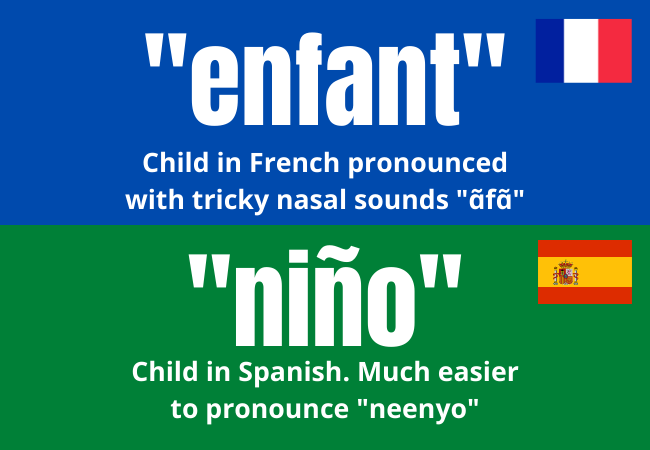
Verb conjugations
The term “verb conjugation” refers to how to form verbs. For example, “I speak” and “She speaks”. The following is the French verb “parler” (to speak) and Spanish verb “hablar” (to speak) conjugated in the present tense.
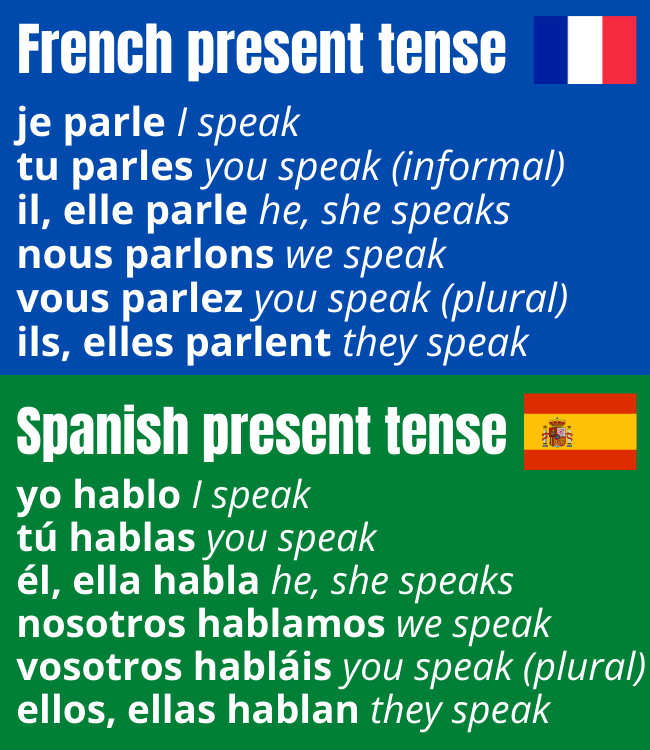
In the initial stages, learning French verbs can be quite challenging.
However, once you master the regular verbs (verbs which follow conjugations in a cookie-cutter pattern) and master the most common irregular verbs in the present tense, learning the more advanced tenses (e.g., Future tense, conditional tense, subjunctive mood) tends to go pretty smoothly.
In Spanish, however, the more advanced tenses beyond the present tense tend to get more complicated.
Specifically, the French past tense called the passé composé, is quite easy. Every person has the same ending. However, the Spanish past tense, called the preterite is quite difficult as each person has a different ending.
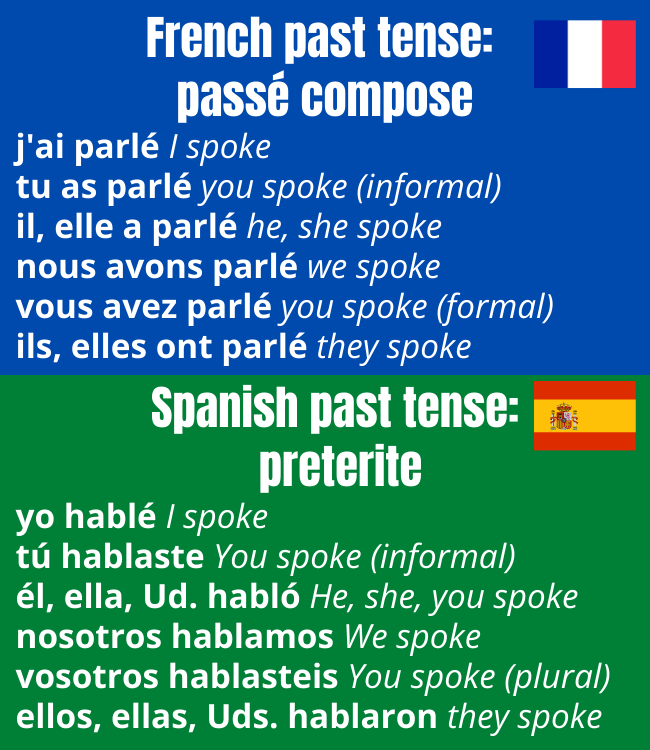
French vs. Spanish: Biggest similarities
French and Spanish have a long list of aspects in common. This is because they both Romantic languages which were derived from Latin. Both the underlying grammatical structures and vocabulary are similar.
If you study French in depth then study Spanish, you’ll find learning Spanish to be very easy. Similarly, if you study Spanish first then study French, you’ll find the process of learning French to be very simple.
Overlapping vocabulary
French and Spanish have what’s called lexical similarities. This means that while word in French and Spanish might not be exactly the same, they are highly related. The following is very brief list of words in French and Spanish that are highly related but not 100% the same.
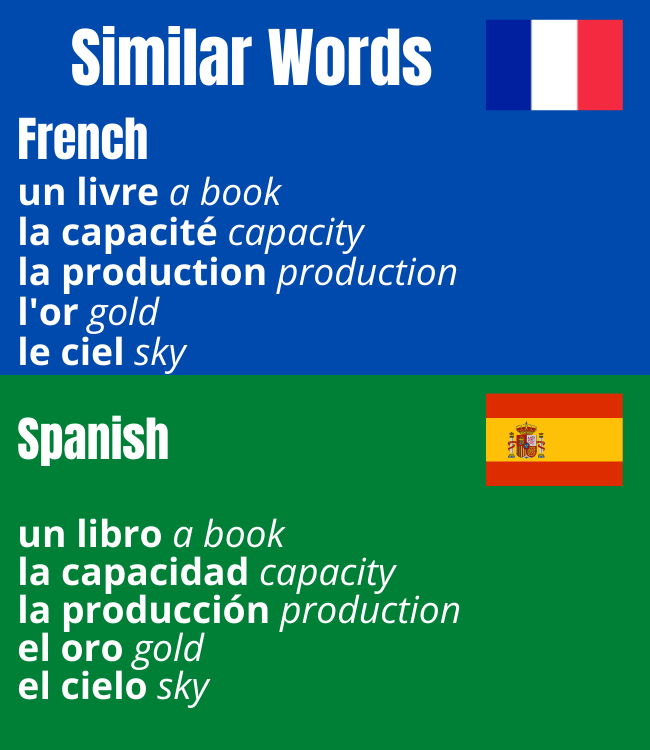
While there are lots of similar words shared by both languages, you cannot assume that once you’re mastered one language, the other will be a freebie or walk in the park.
Here’s a very brief list of words that are completely different in French and Spanish.
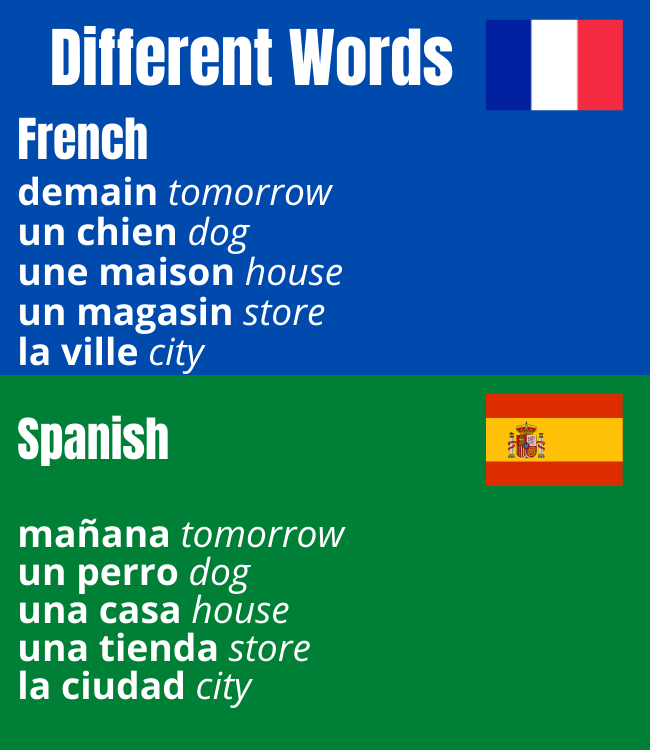
Both languages have groups of “regular” and “irregular” verbs.
Both French and Spanish have what are called “regular verb groups”. These are categories of verbs which follow the same conjugation patterns.
In French, the regular verb groups have infinitives (to forms of the verbs) than end in the letters -er, -ir and -re. In Spanish, the regular verb groups have letters ending in -ar, -ir and -re.
Understanding the concept of how regular verbs works is an important initial step in learning both languages.
In both languages many basic verbs are similar to each other. For example, in French “parler” means to speak and is common regular -er verb (one of the major groups). In Spanish, “hablar” means to speak and is a common regular -ar verb (one of the major groups).
Irregular verbs are verbs which do not follow the conjugation patterns of regular verbs.
In both languages, equivalent verbs are often irregular. In French, for example, “devoir” (must, have to) is irregular while the same Spanish verb “deber” (must, have to) is also irregular.
French and Spanish have an imperfect tense
Both French and Spanish have what’s called the “imperfect tense”. This tense is used to describe actions which used to occur in the past or were occurring.
A big difficulty for students of both languages is trying to understand when to use the imperfect and when to use the passé composé (in French) and preterite (in Spanish).
This page on the French imperfect tense explains the difference between these two past tenses. This page covers the Spanish imperfect.
Again, the differences between them are basically the same between French and Spanish.
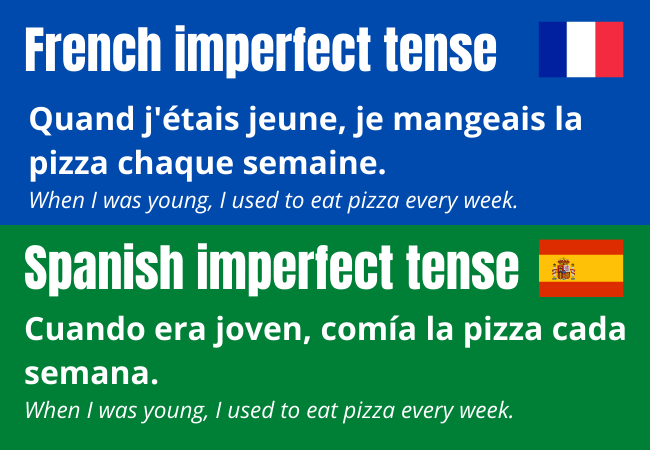
Future and conditional tenses
The underlying principles behind the future (will) and conditional (would) in French and Spanish are the same: endings are added to the end of an infinitive (to form of the verb).
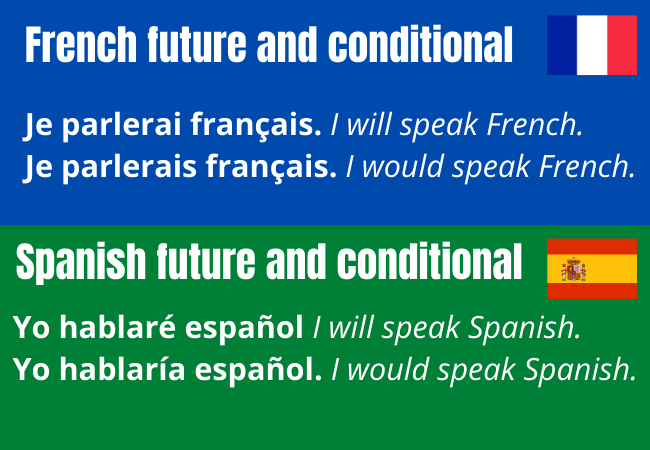
French and Spanish have reflexive verbs
Both French and Spanish have reflexive verbs. A reflexive verb is a verb that has a reflexive pronoun between the personal pronoun (i.e., je) and the verb.
In French, “Je me lave” means I wash myself, rather than “Je lave la voiture” (I wash the car). The “me” means to myself.
Spanish reflexive verbs work in the exact same manner. “Yo me lavo” means “I wash myself” and “Yo lavo el coche” means I wash the car.
Reflexive verbs work the exact same way in both same languages. This page covers French reflexive verbs an this page covers Spanish reflexive verbs.
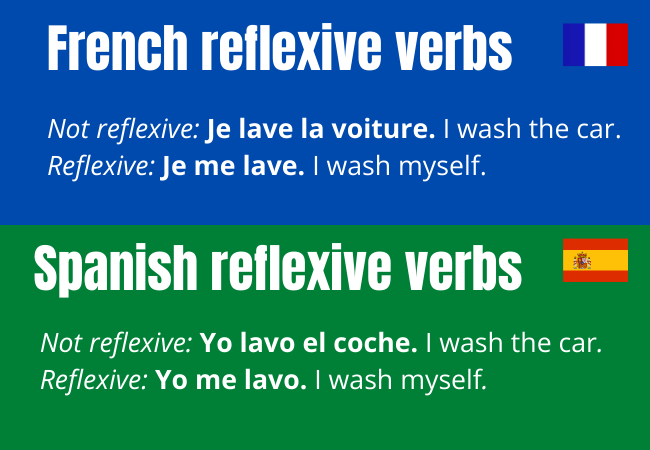
French and Spanish have a subjunctive mood
Both French and Spanish have what is called the “subjunctive mood”. This tense is called a mood because it is used to express the feelings of the speaker, which are “subjective”.
For the usage of the subjunctive in both languages, often (but not always) two subjects (people) are required separated by the word “que”, which means “that” in both langauges.
The underlying principals behind the subjunctive mood are the same for both French and Spanish. The subjunctive is used for expressing wishes, emotions and doubts.
Furthermore, both French and Spanish have unique verb conjugations for the subjunctive. This page overs the French subjunctive mood and this page covers the Spanish subjunctive.
Students of both languages often called this the “dreaded subjunctive” because it’s perceived to be difficult.

French and Spanish have two verbs for “to know”
Both French and Spanish have two verbs to express “to know”.
The underlying principle is that one verb (Savoir in French and Saber in Spanish) is used for knowing facts and another verb (connaitre in French and conocer in Spanish) is used for expressing knowledge of people, places and areas of study.
This page explains savoir vs. connaître in French and this page explains saber vs. conocer in Spanish.
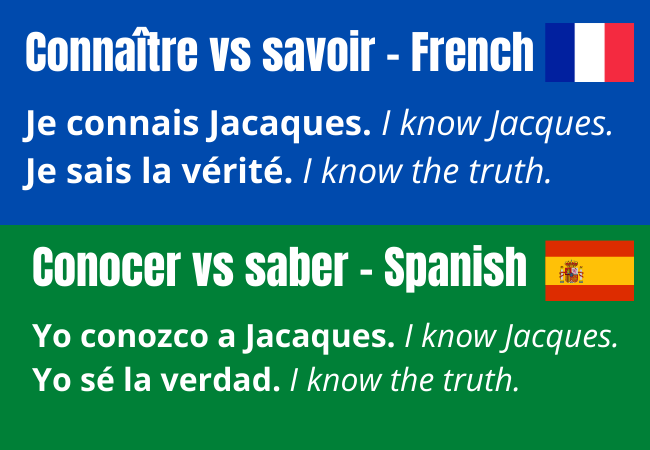
French vs. Spanish: Biggest differences
Être (to be in French) vs. Ser and Estar in Spanish
In French, there is one single verb for “to be”: être. As a student, all you have to do is memorize one single verb to express I am (je suis), you are (tu es), etc.
In Spanish, however, there are two verbs for to be: Ser and estar. The verb “ser” is used to express things that are permanent. For example, Yo soy un hombre (I am a man).
The other verb for “to be”, estar, is used to express things that are impermanent and always changing, such as moods, for example: “Yo estoy bien” (I am well) or “Yo estoy feliz” (I am happy).
Learning the difference between ser and estar is an aspect that makes Spanish harder to learn than French.
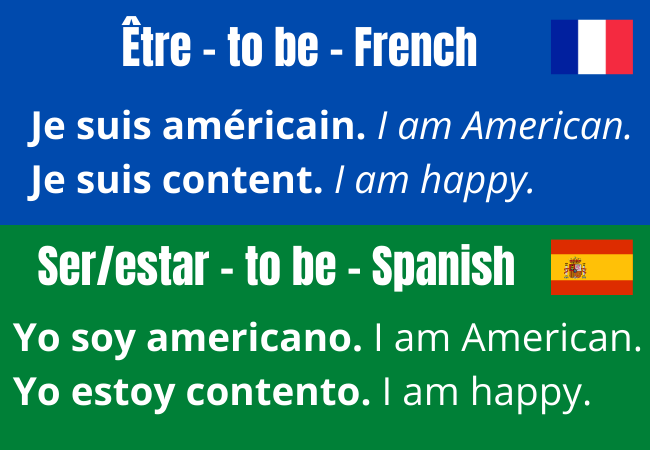
Usage of accent marks
A major difference between French and Spanish is the usage of accent marks.
In French, the accent marks often are used to indicate how to pronounce a letter. For example, when there’s an upward slanging accent over the “é”, the sound of the -e becomes “ay” as in play. A downward slanging accent “è” causes the -e to sound like “eh”.
This page offers a complete overview of the French accents, their usage and reading rules.
In Spanish, however, accents are used to indicate which syllable to emphasize on a given word. For example, “Hablo” is means “I speak” whereas “Habló” means “he spoke” or “she spoke”. In the latter, the second syllable would receive the emphasis.
This page explains Spanish accent marks.
Masculine and feminine nouns
Nouns (things) in both French and Spanish are assigned a gender, either masculine or feminine. Learning the gender of nouns is requirement for both languages and can take some time to get used to.
In general and with few exceptions, memorizing the gender of Spanish nouns is quite simple: Nouns ending in the letter -a are feminine. This aspect makes learning Spanish much easier than learning French.
French gender rules for nouns, however, are much more complicated. Many people assume that French all feminine nouns end in -e. But, this is simply not true.
There is no set pattern in French for the gender of nouns. However, with time you will develop a sense of which nouns are masculine and which are feminine.
This page covers the gender of French nouns, and specifically the nouns’ endings, in detail.
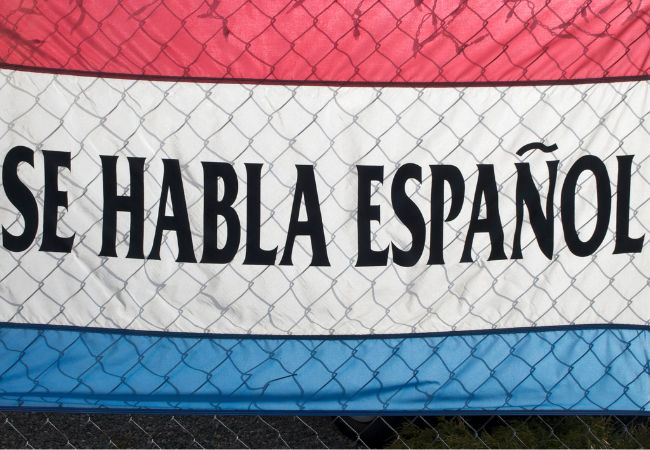
Spanish usage of the progressive tense
In French the present tense, “Je parle” translates to both “I speak” and “I am speaking. These English equivalent tenses are the simple present an present continuous.
Another way to express the present continuous in French is “être en train de + infinitive“. For example, “Je suis en train de parler” means “I am speaking”. French uses this form to emphasize being in the “middle” of doing something.
Generally, French simply uses the present tense to express “ing”.
Spanish, however, puts a heavy emphasis on the progressive tense to express “ing” or the present continuous.
The Spanish present continuous is formed by adding a present participle to estar (to be). For example, “Estoy hablando” translates to “I am speaking” as in “I am speaking right now”.
The Spanish present tense, “Yo hablo” would be used to indicate speaking a language, for example. “Yo hablo ingles” (I speak English).
This heavy usage of the Spanish present continuous (also called the progressive present) is a major difference between French and Spanish.
Imperative
The imperative tense is is use for commands. Eat! Speak! Let’s go!
In Spanish, the imperative is much harder than in French. This is because the forms change between the affirmative imperative and negative imperative (Do! and Don’t do!).
For example, “¡Habla!” means “Speak!” while “¡No hables!” means “Don’t speak!”. These differences in verb endings must be memorized throughout the langauge.
In French, however, the imperative is much more simple. “Parle!” means “Speak!” and “Ne parle pas!” means “Don’t speak!”. The endings in the French imperative do not change depending on affirmative or negation.
This page explains the French imperative tense in detail and this page explores the Spanish imperative.
French vs. Spanish – Summary Table
The following table summarizes the key similarities and differences between French and Spanish.
| French vs. Spanish | Comments |
| Usefulness | French is useful in France, a few more European countries, Canada, the South Pacific and Western Africa. Spanish is a major global language used in Spain, most of Latin American and extensively in the United States. |
| Pronunciation | Overall, Spanish pronunciation is much easier. It is a phonetic language. French pronunciation is much harder and learning to read take some time and patience. |
| Accent marks | French accent marks can affect pronunciation of vowels. Spanish accent marks are used to indicate syllable emphasis. |
| Grammar | Both languages have very similar grammatical systems. It's suggest to learn one language first very well, then try the other. |
| Verb conjugations | French verbs start hard in the present tense. Advanced tenses become easier. Spanish verbs remain difficult, even in advanced tenses. |
| Regular and irregular verbs | Both languages have both regular and irregular verbs. The underlying principles behind verb groups are similar. |
| The verb for "to be" | Spanish has two separate verbs for to be. This makes learning Spanish difficult. French has one single verb. |
| Masculine and feminine of nouns | Spanish gender rules are very easy. Most feminine nouns in -a. Learning the gender of French nouns is much harder. |
| Imperfect tense | Both languages have an imperfect tense. The underlying principles are the same. |
| Reflexive verbs | Both French and Spanish have reflexive verbs. These are the "to myself" verbs. |
| Subjunctive mood | Both languages have a subjunctive mood. The underlying principles are the same. |
| Progressive tense | Spanish puts heavy emphasis on its progressive tense. French tends to use the present indicative more. |
| Imperative tense | The Spanish imperative is difficult due to changing forms. The French imperative is easier. |
| Future and conditional tense | The underlying principals behind the future and conditional tense are the same. Endings are added to the infinitives. |


